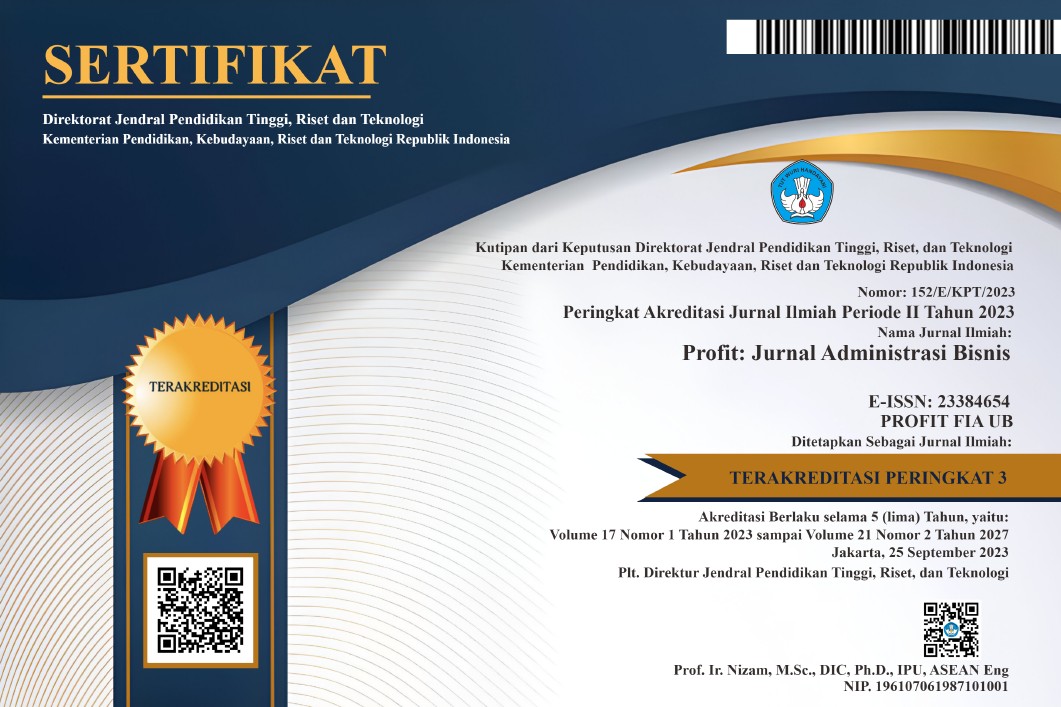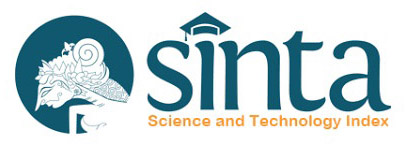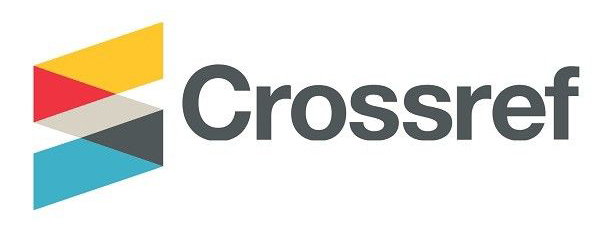PERAN STAKEHOLDER DALAM PEMBANGUNAN PARIWISATA DI PULAU SAMOSIR
DOI:
https://doi.org/10.21776/ub.profit.2020.014.01.5Keywords:
stakeholders, Lake Toba, DMO, destination developmentAbstract
Samosir Island is known as the tourism center of Lake Toba Region that is managed based on DMO concept in 2010-2015. This study aims to identify the profile and tourism attractiveness of Samosir Island, and toidentify and analyze the role of stakeholders through DMO. The researcher used descriptive methods, and used primary and secondary data collected by observation, interview and documentation techniques. The results showed that most of the tourism activities on Samosir Island are related to Batak culture so that local community has an important role in maintaining the sustainability of attractions. There has not been found any good cooperation relations between the government, local communities, and the private sector in the development of Samosir Island tourism. Local communities choose to manage resources especially cultural sites independently. Similar conditions are also found in the private sector where business activities have not been running wuth an appropriate management strategy. Lack of continous control by the local government causes a decrease in the quality of service providers related attractions, amenities, and accessibility.
References
Abdurahman, B. (2014). Destination Management Organization in Flores. Jurnal Kepariwisataan Indonesia, 9.
Aleksandrov, K. (2012). The Role of DMO for Sustainable Development of a Tourist Destination - Bulgaria Case. In L. Dimitris (Ed.), Journal of Tourism Research (Vol. 9, pp. 198–209). Tourism Research Institute.
Andriani, R., Brahmanto, E., Purba, C. C. S., Tari, V., Tari, V., & Meningkatkan, S. D. (2013). Value Tari Sigale-Gale Dalam Meningkatkan Wisata Budaya Desa Tomok Kabupaten Samosir. (1), 25–35.
Adriani, Y. (2015). Pengembangan Kelembagaan DMO. Tanjungpandan.
Ardika, I. G. (2014). Peran Strategik DMO Dalam Penyelenggaraan Kepariwisataan Indonesia. Jakarta.
Baloglu, S., & Uysal, M. (1996). Market segments of push and pull motivations: a canonical correlation approach. International Journal of Contemporary Hospitality Management, 8(3), 32–38.
Barrow, G. C. (2013). Interpretation planning and its role in sustainable tourism and visitor management at geoheritage sites. International Journal of Geoheritage, 1(1), 30–38.
Beritelli, P., Buffa, F., & Martini, U. (2015). The coordinating DMO or coordinators in the DMO? – an alternative perspective with the help of network analysis. Tourism Review, 70(1), 24–42. https://doi.org/10.1108/TR-04-2014-0018
Bornhorst, T., Brent Ritchie, J. R., & Sheehan, L. (2010). Determinants of tourism success for DMOs & destinations: An empirical examination of stakeholders’ perspectives. Tourism Management, 31(5), 572–589. https://doi.org/10.1016/j.tourman.2009.06.008
BPIW. (2018). Dokumen Profil Pengembangan Kawasan Strategis - Resume Kawasan Danau Toba. Retrieved from http://bpiw.pu.go.id/product/get_index/
Brohman, J. (1996). New directions in tourism for Third World development. Annals of Tourism Research, 23(1), 48–70. https://doi.org/10.1016/0160-7383(95)00043-7
Camilleri, M. (2018). Travel Marketing, Tourism Economics and The Airline Product an Introduction to Theory and Practice. Switzerland. Springer Nature.
Currie, C., & Falconer, P. (2014). Maintaining sustainable island destinations in Scotland: The role of the transport-tourism relationship. Journal of Destination Marketing and Management, 3(3), 162–172. https://doi.org/10.1016/j.jdmm.2013.10.005
Cooper, C., Fletcher, J., Gilbert, D., & Wanhill, S. (1993). An Introduction to Tourism. Tourism Principles and Practice, 7–12.
Ekawati, S., Supriyanto, B., Panjaitan, J. H., & Mulyadi, Y. (2016). Mendorong Pengembangan Danau Toba Sebagai Destinasi Pariwisata Prioritas. Policy Brief, 10(8), 1–4.
Freeman, E. (1984). Strategic Management: a Stakeholder Approach. Boston: Pitman.
Gunn, C. (1998). Vacationscape: The Design of Travel Environments. New York: Van Nostrand Reinhold Company.
Haywood, M. (2005). Economic Business Cycles and the Tourism Life-Cycle Concept. In K. Loannides, Dimitri; Debbage (Ed.), The Economic Geography of the Tourist Industry: a Supply-side Analysis (pp. 275–286). London: Routledge.
Huang, S., Hsu, C. H. C., & Chan, A. (2010). Tour guide performance and tourist satisfaction: A study of the package tours in Shanghai. Journal of Hospitality and Tourism Research, 34(1), 3–33. https://doi.org/10.1177/1096348009349815
Hu, W., & Wall, G. (2005). Environmental management, environmental image and the competitive tourist attraction. Journal of Sustainable Tourism, 13(6), 617–635. https://doi.org/10.1080/09669580508668584
Khan, H., Seng, C. F., & Cheong, W. K. (1990). Tourism multiplier effects on Singapore. Annals of Tourism Research, 17(3), 408–418. https://doi.org/10.1016/0160-7383(90)90006-D
Leakota, L. (2015). The Importance of Rural Communities’ Participation in the Management of Tourism Management: a Case Study from Lesotho. Worldwide Hospitality and Tourism Themes, (Unit 07), 453–462. Retrieved from http://dx.doi.org/10.1108/WHATT-06-2015-0029
Malau, G. (1994). Dolok Pusuk Buhit. Jakarta Timur: PT. Balai Pustaka.
Murphy, P., & Murphy, A. (2004). Strategic Management for Tourism Communities: Brigding the Gaps. Canada: Cormwell Press.
Pardede, F. R. E. P., & Suryawan, I. B. (2016). Strategi Pengelolaan Kabupaten Samosir Sebagai Daya Tarik Wisata Alam Di Provinsi Sumatera Utara. Jurnal Destinasi Pariwisata, 4(1), 14. https://doi.org/10.24843/jdepar.2016.v04.i01.p03
Pitana, I G; Gayatri, P. G. (2005). Sosiologi Pariwisata. Yogyakarta: Andi.
Pitana, I. G., & Diarta, I. K. (2009). Pengantar Ilmu Pariwisata. Yogyakarta: Andi.
Rahim, F. (2010). Pedoman Pembentukan dan Pengembangan Destination Management Organization (DMO). Jakarta: Kementerian Kebudayaan dan Pariwisata.
Rahim, F. (2012). Buku Pedoman Kelompok Sadar Wisata. Jakarta: Kementerian Kebudayaan dan Pariwisata.
Siallagan, A. (2011). Analisis Permintaan Wisatawan Nusantara Objek Wisata Batu Kursi Siallagan, Kecamatan Simanindo, Kabupaten Samosir. Universitas Diponegoro.
Smaranda, Simoni; Daniela, M. (2012). Tourism Organization and Coordination in Australia and the Managerial Strategy for Tourism Development. Journal of Knowledge Management, Economics and Information Technology, 2 (5), 1–10.
Spillane, J. (1991). Ekonomi Pariwisata, Sejarah dan Prospeknya. Yogyakarta: Kanisius.
Suharto, B. (2011). Tata Kelola Organisasi Destinasi Candi Borobudur. Jurnal Ekonomi Manajemen Sumber Daya, 12(1), 35–49.
Suwantoro, G. (2004). Dasar-dasar Pariwisata. Yogyakarta: Andi.
Varghese, B., Paul, J., & Itty, N. (2014). a Literature Review on Destination Management Organization (DMO). Strategic Interventions of DMO in tourism View project Medical Tourism View project. Zenitt, International Journal of Multidisciplinary Research, 4(12), 82 88. Retrieved from https://www.researchgate.net/publication/269114247
Wardani, Mentari; Nasution, N. (2016). Kontribusi Pengembangan Pariwisata Danau Toba Melalui Skema BOP ( Badan Otorita Pariwisata) Bagi Masyarakat di Sekitar Danau Melalui Skema BOP.
Yoeti, O. (1996). Pengantar Ilmu Pariwisata. Bandung: Angkasa.
Yoeti, O. (2013). Pengantar Ilmu Pariwisata. Bandung: Angkasa.
Zhang, J., Inbakaran, R. J., & Jackson, M. S. (2006). Understanding community attitudes towards tourism and host-guest interaction in the urban - Rural border region. Tourism Geographies, 8(2), 182–204. https://doi.org/10.1080/14616680600585455
Downloads
Published
Issue
Section
License
The copyright of the received article shall be assigned to the journal as the publisher of the journal. The intended copyright includes the right to publish the article in various forms (including reprints). The journal maintains the publishing rights to the published articles.

This work is licensed under a
Creative Commons Attribution-NonCommercial 4.0 International License

















